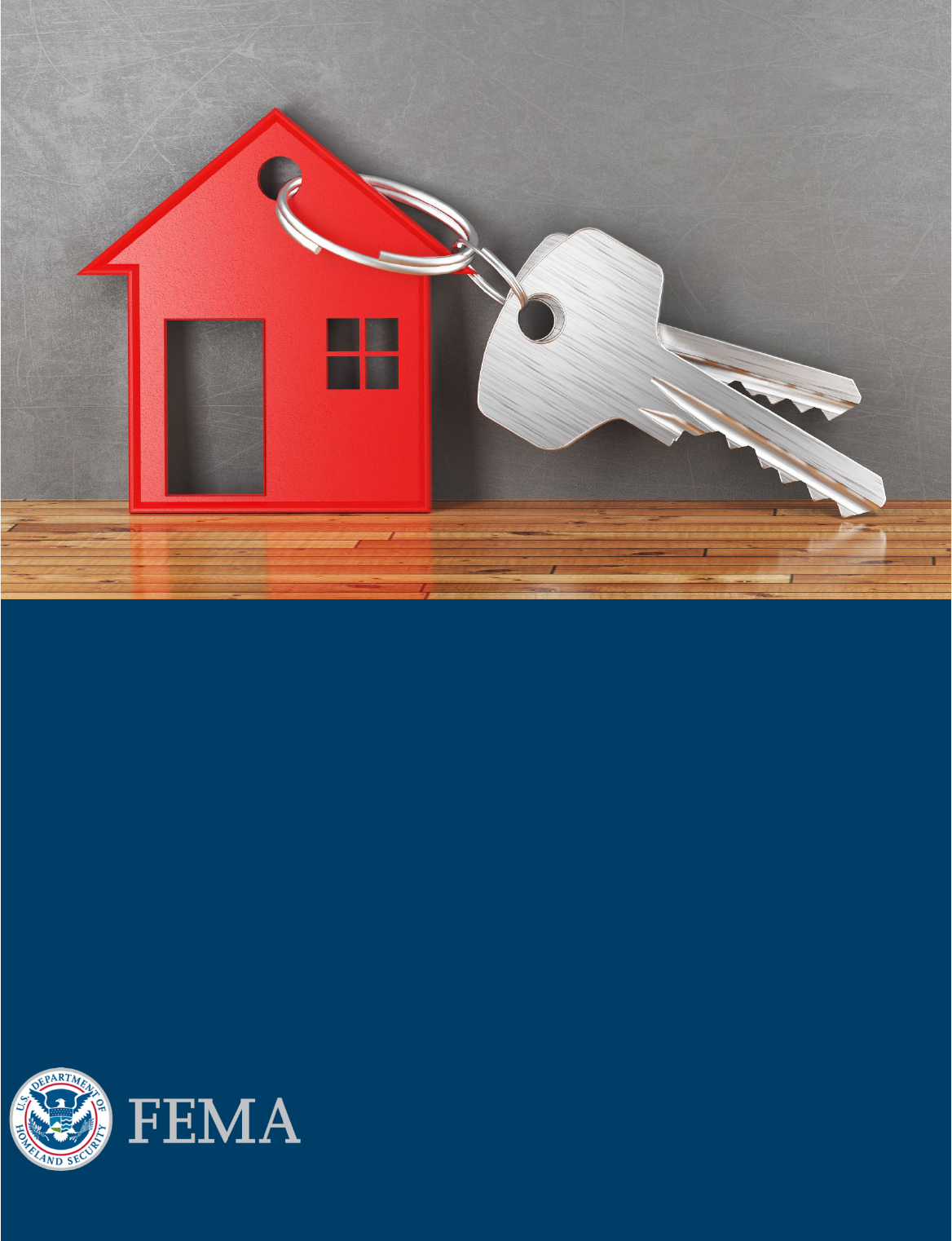
Flood Risk Disclosure
Model State Requirements for Disclosing Flood Risk
During Real Estate Transactions
July 11, 2022

State Flood Risk Disclosure Best Practices
For Public Release i
Table of Contents
1. Disclosing Flood Risk Helps Protect Life and Property ............................................................ 1
1.1. Intended Audience .......................................................................................................... 1
1.2. Intended Use ................................................................................................................... 1
2. Models for Strong State Flood Risk Disclosure Requirements ............................................... 1
2.1. Summary Flood Risk Disclosure Requirements Found in State Disclosure Laws and
Forms ............................................................................................................................... 2
2.2. Detailed Examples from States with Strong Flood Risk Disclosure Requirements .... 3
2.2.1. Louisiana ........................................................................................................................ 4
2.2.2. Texas ............................................................................................................................... 6
2.2.3. South Carolina ................................................................................................................ 8
2.2.4. Mississippi ...................................................................................................................... 9
2.2.5. Delaware ...................................................................................................................... 10
Appendix A. Analysis of the Relationship Between State Flood Risk Disclosure Requirements and
Flood Insurance Penetration Rates .............................................................................. 12
Appendix B: Analysis of State Flood Risk Disclosure Requirements ........................................... 16
Appendix C: All State Statutes and Mandatory Disclosure Forms ............................................... 19

State Flood Risk Disclosure Best Practices
For Public Release 1
1. Disclosing Flood Risk Helps Protect Life and Property
Floods are costly to homeowners – a single inch of flooding can cost up to $25,000.
1
For an
uninsured homeowner, a flood can be devastating. Knowing the risk of flooding is the first step
toward adequately protecting lives and property. That knowledge can help individuals, families, and
communities.
Disclosing flood risk information during real estate transactions is a timely and effective way to
enable homeowners to make better risk-informed investment decisions. Currently, no federal
statutes require property sellers to disclose information about flood risk or prior flood damage.
However, states can take action to protect home buyers in their state by enacting laws and
implementing practices that require disclosure of flood risk. In fact, states with strong flood risk
disclosure requirements often also have higher rates of residential flood insurance uptake.
2
When
more at-risk individuals and families are covered by a flood insurance policy, communities can
recover more quickly and more fully after floods.
As of the date of publication, 35 states have enacted some form of legal or regulatory mechanism
requiring property sellers to disclose factors related to flood risk about their property. This guide
identifies states with the strongest flood risk disclosure requirements and provides a selection of
their laws and disclosure forms as models for use in introducing or strengthening a state’s real
estate disclosure requirements.
1.1. Intended Audience
This guide is primarily intended for use by technical flood risk experts and by elected and career
officials responsible for legislative action at the state and territory level. It might also be consulted by
all others interested in flood risks and their disclosure.
1.2. Intended Use
This guide helps its intended audience develop or refine existing state laws and/or real estate
disclosure forms to strengthen their state’s flood risk disclosure mechanisms.
2. Models for Strong State Flood Risk Disclosure
Requirements
States often enact real estate disclosure laws. Such laws require written statements from a seller
that disclose any facts about the property that are material to its value, such as prior flood damage
and flood risk. To implement real estate disclosure laws, states may mandate the use of official
disclosure forms to guide and standardize disclosure statements that must accompany real estate
1
https://www.floodsmart.gov/cost-flooding.
2
See Appendix A for the method used to analyze the relationship between state flood risk disclosure requirements and
statewide residential flood insurance penetration.

State Flood Risk Disclosure Best Practices
For Public Release 2
transactions, often at the time of offer. These disclosure forms frequently include specific
disclosures related to flood risk. The relevant disclosures may make real estate markets work better,
because mandatory disclosure can promote informed choices.
On June 7
th
, 2022, FEMA conducted and finalized a review and analysis of state real estate
disclosure laws and mandated disclosure forms. A state-by-state view of the flood risk disclosure
requirements that FEMA found is included in Appendix B and Appendix C of this document. The
insights from this review and analysis are summarized in the subsequent sections.
2.1. Summary Flood Risk Disclosure Requirements Found in State
Disclosure Laws and Forms
The following 10 flood risk disclosures are commonly found in state disclosure laws and/or legally
mandated disclosure forms. These include disclosures of:
1. Whether the property is in a flood hazard area and/or the Federal Emergency Management
Agency (FEMA) Flood Zone in which the property is located
2. A federal requirement to purchase flood insurance at the property
3. The presence of an active flood insurance policy for the property
4. The current cost of flood insurance premiums for the property
5. Previous flood events and/or flood-related property damage
6. Any past flood insurance claims
7. Past flood insurance claim dates and amounts
8. Any past disaster-related aid provided (federal, state, or local)
9. Past disaster-related aid dates and amounts
10. Other related disclosures (e.g., elevation certificates, areas subject to inundation, etc.)
Figure 1 shows the distribution of these 10 state disclosure laws and implementation practices
across the states. Some states explicitly require four or more flood risk disclosures, while others
explicitly require fewer than that, and imply one or more of such disclosures. Several states do not
legally require sellers to disclose a property’s flood risk information at all.
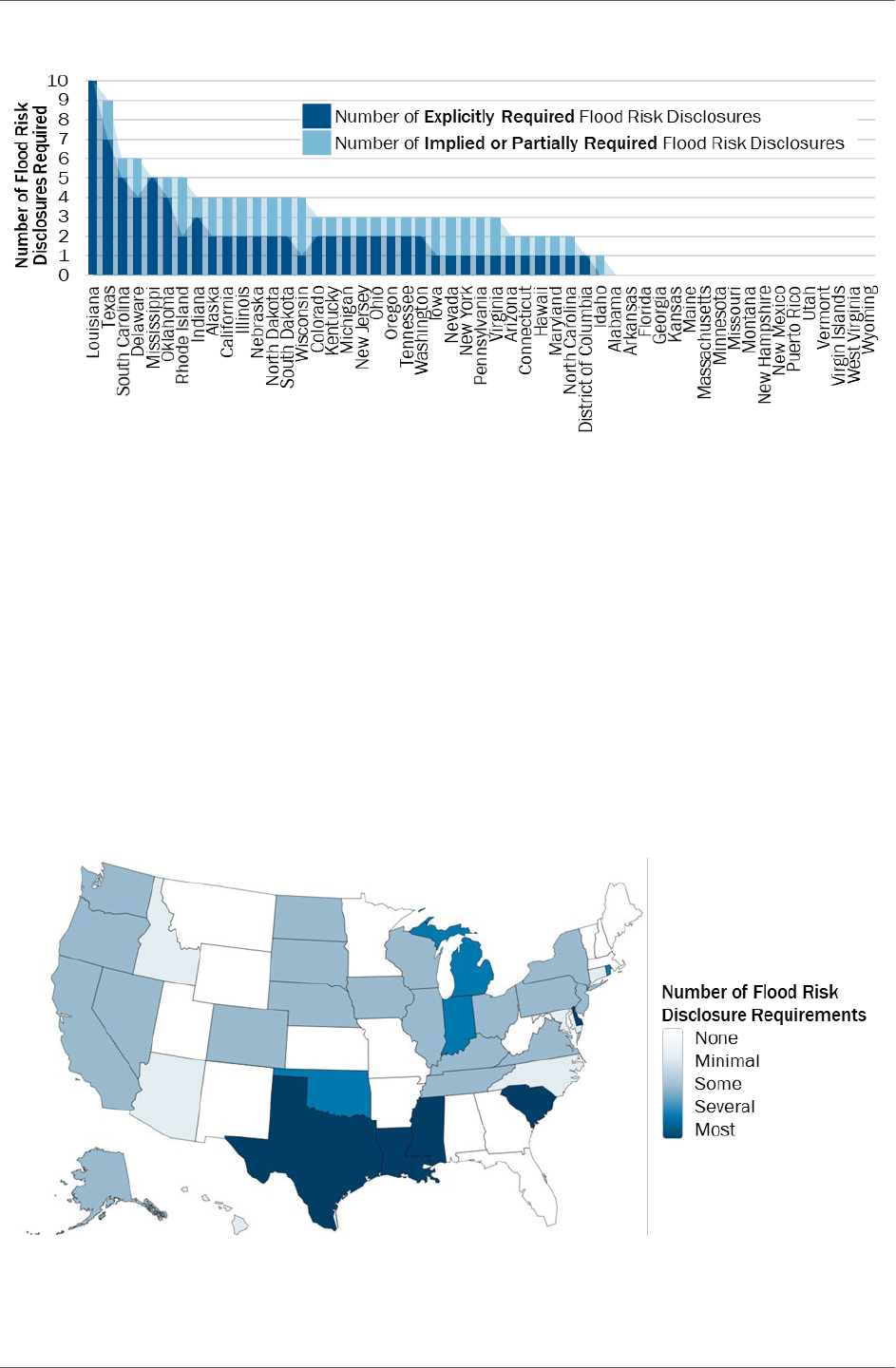
State Flood Risk Disclosure Best Practices
For Public Release 3
Figure 1: Number of Mandated Flood Risk Disclosures by State
Among the 35 states that legally require flood risk disclosures, the most common disclosures are:
1) whether the property has experienced past flood damage or has flooding problems and 2)
whether the property is located in a FEMA-designated SFHA or flood zone. The least common state-
mandated flood risk disclosures relate to whether the property has received flood insurance claim
payments and/or received other disaster aid as a result of past flood damage. Some states also
mandate other types of flood-related disclosures such as whether the property is considered a
“Repetitive Loss Property” by the NFIP or is located in a dam inundation area.
2.2. Detailed Examples from States with Strong Flood Risk Disclosure
Requirements
Several states have mandated multiple flood risk disclosures as part of their laws and/or disclosure
forms. As illustrated in dark blue in Figure 2 below, five states (Louisiana, Texas, South Carolina,
Mississippi, and Delaware) have the most flood risk disclosure requirements.
Figure 2: The Strength of State Flood Risk Disclosure Requirements Across the Nation

State Flood Risk Disclosure Best Practices
For Public Release 4
The following subsections highlight these states’ approaches. Appendix C provides the state statutes
and links to state mandated disclosure forms.
For each state model, the following symbols are used to illustrate how the state’s law or
disclosure form addresses the 10 flood risk disclosure types:
Explicitly required
P Partially required or implied
Not required
2.2.1. LOUISIANA
As set forth in Louisiana Revised Statute § 9:3196-3200, a seller of residential real property must
furnish buyers with a Property Disclosure Document. The state of Louisiana requires sellers to use
the form promulgated by the Louisiana Real Estate Commission or another form that contains
substantially the same information.
Flood risk disclosures required in the state’s law and/or mandatory disclosure form:
Location of the property in a flood hazard area and/or the FEMA Flood Zone (e.g., A, V, X) in
which the property is located
A federal requirement to purchase flood insurance at the property
The presence of an active flood insurance policy for the property
The current cost of flood insurance premiums for the property
Previous flood events and/or flood-related property damage
Any past flood insurance claims
Past flood insurance claim dates and amounts
Any past disaster-related aid provided (federal, state, or local)
Past disaster-related aid dates and amounts
Other related disclosures (e.g., elevation certificates)
Flood Risk Disclosure Questions Contained in Louisiana’s Mandated Disclosure Form
(1) Has any flooding, water intrusion, accumulation, or drainage problem been
experienced with respect to the land: (a) during the time the SELLER owned the
property? Y N If yes, indicate the nature and frequency of the defect at the end of
this section. (b) prior to the time the SELLER owned the property?
[ ]Y [ ]N [ ]UNK
If yes, indicate the nature and frequency of the defect at the end of this section.
(2) Has any structure on the property ever flooded, by rising water, water intrusion
or otherwise?
a. during the time the SELLER owned the property?
[ ]Y [ ]N

State Flood Risk Disclosure Best Practices
For Public Release 5
b. prior to the time the SELLER owned the property?
[ ]Y [ ]N [ ]UNK
If yes, give the nature and frequency of the defect at the end of this section.
(3) What is/are the flood zone classification(s) of the property? __________ What is the
source and date of this information? Check all that apply.
[ ] Survey / Date _________
[ ] Elevation Certificate / Date
[ ] Other / Date
[ ] FEMA Flood Map - https://msc.fema.gov/portal or https://www.floodsmart.gov/flood-
map-zone/find-yours
Other: _____________________________
(4) SPECIAL FLOOD HAZARD AREAS. If the property is located within a designated
special flood hazard area on a map prepared by the Federal Emergency
Management Agency, the federal law (42 U.S.C. § 4104a, et seq.), mandates that
prospective purchasers be advised that flood insurance may be required as a
condition of obtaining financing. Is the property within a designated special flood
hazard area?
[ ]Y [ ]N
(5) Is there flood insurance on the property?
[ ]Y [ ]N
IF YES, A COPY OF THE POLICY DECLARATIONS PAGE SHALL BE ATTACHED AND BECOME
PART OF THIS PROPERTY DISCLOSURE DOCUMENT.
(6) Does SELLER have a flood elevation certificate that will be shared with BUYER?
[ ]Y [ ]N
(7) Has the SELLER made a private flood insurance claim for this property?
[ ]Y [ ]N [ ]UNK
a. If YES, was the claim approved?
[ ]Y [ ]N [ ]UNK
b. If YES, what was the amount received? _________________
(8) Did the previous owner make a private flood insurance claim for this property?
[ ]Y [ ]N [ ]UNK
a. If YES, was the claim approved?
[ ]Y [ ]N [ ]UNK
b. If YES, what was the amount received? _________________________
(9) Has the SELLER made an NFIP claim for this property?
[ ]Y [ ]N [ ]UNK

State Flood Risk Disclosure Best Practices
For Public Release 6
a. If YES, was the claim approved?
[ ]Y [ ]N [ ]UNK
b. If YES, what was the amount received? ________________
(10) Did the previous owner make an NFIP claim for this property?
[ ]Y [ ]N [ ]UNK
a. If YES, was the claim approved?
[ ]Y [ ]N [ ]UNK
b. If YES, what was the amount received? ________________
(11) FLOOD DISASTER INSURANCE. If the SELLER or previous owner has previously
received federal flood disaster assistance and such assistance was conditioned
upon obtaining and maintaining flood insurance on the property, federal law, i.e.,
42 U.S.C. § 5154a, mandates that prospective purchasers be advised that they will
be required to maintain insurance on the property and that if insurance is not
maintained and the property is thereafter damaged by a flood disaster, the
purchaser may not be eligible for additional Federal flood disaster assistance. To
the best of the SELLER’s knowledge, has federal flood disaster assistance been
previously received with regard to the property?
[ ]Y [ ]N [ ]UNK
a. If YES, from which federal agency (e.g., FEMA, SBA)? ____________________________
b. If YES, what was the amount received? ________________________________________
c. If YES, what was the purpose of the assistance (e.g., elevation, mitigation, restoration)?
__________________________________________________________________________.
2.2.2. TEXAS
As set forth in Texas Property Code § 5.008, the state of Texas requires sellers to provide written
notice of a property’s condition to the purchaser and mandates the use of an official disclosure form
developed by the Texas Real Estate Commission.
Flood risk disclosures required in the state’s law and/or mandatory disclosure form:
Location of the property in a flood hazard area and/or the FEMA Flood Zone (e.g., A, V, X) in
which the property is located
P A federal requirement to purchase flood insurance at the property
The presence of an active flood insurance policy for the property
The current cost of flood insurance premiums for the property
Previous flood events and/or flood-related property damage
Any past flood insurance claims
P Past flood insurance claim dates and amounts
Any past disaster-related aid provided (federal, state, or local)
P Past disaster-related aid dates and amounts

State Flood Risk Disclosure Best Practices
For Public Release 7
Other related disclosures (e.g., elevation certificates, etc.)
Flood Risk Disclosure Questions Contained in Texas’s Mandated Disclosure Form
(1) Are you (Seller) aware of any of the following conditions*? Write Yes (Y) if you
are aware, write No (N) if you are not aware.
______ Present flood insurance coverage
______ Previous flooding due to a failure or breach of a reservoir or a controlled or
emergency release of water from a reservoir
______ Previous water penetration into a structure on the property due to a natural flood
event
(2) Write Yes (Y) if you are aware, and check wholly or partly as applicable, write No
(N) if you are not aware.
______ Located [ ] wholly or [ ] partly in a 100-year floodplain (Special Flood Hazard Area-
Zone A, V, A99, AE, AO, AH, VE, or AR)
______ Located [ ] wholly or [ ] partly in a 500-year floodplain (Moderate Flood Hazard
Area-Zone X (shaded))
______ Located [ ] wholly or [ ] partly in a floodway
______ Located [ ] wholly or [ ] partly in a flood pool
______ Located [ ] wholly or [ ] partly in a reservoir
If the answer to any of the above is yes, explain (attach additional sheets if necessary):
_____________________________________________________________________________
*For purposes of this notice:
"100-year floodplain" means any area of land that:
(A) is identified on the flood insurance rate map as a special flood hazard area, which
is designated as Zone A, V, A99, AE, AO, AH, VE, or AR on the map;
(B) has a one percent annual chance of flooding, which is considered to be a high risk
of flooding; and
(C) may include a regulatory floodway, flood pool, or reservoir.
“500-year floodplain” means any area of land that:
(A) is identified on the flood insurance rate map as a moderate flood hazard area,
which is designated on the map as Zone X (shaded); and
(B) has a two-tenths of one percent annual chance of flooding, which is considered to
be a moderate risk of flooding.

State Flood Risk Disclosure Best Practices
For Public Release 8
“Flood pool” means the area adjacent to a reservoir that lies above the normal
maximum operating level of the reservoir and that is subject to controlled inundation under
the management of the United States Army Corps of Engineers.
“Flood insurance rate map” means the most recent flood hazard map published by the
Federal Emergency Management Agency under the National Flood Insurance Act of 1968
(42 U.S.C. Section 4001 et seq.).
“Floodway” means an area that is identified on the flood insurance rate map as a
regulatory floodway, which includes the channel of a river or other watercourse and the
adjacent land areas that must be reserved for the discharge of a base flood, also referred to
as a 100-year flood, without cumulatively increasing the water surface elevation of more
than a designated height.
“Reservoir” means a water impoundment project operated by the United States Army
Corps of Engineers that is intended to retain water or delay the runoff of water in a
designated surface area of land.
(3) Have you (Seller) ever filed a claim for flood damage to the property with any
insurance provider, including the National Flood Insurance Program (NFIP)*?
[ ] Yes [ ] No.
If yes, explain (attach additional sheets as necessary):
_________________________________________________________________________
*Homes in high risk flood zones with mortgages from federally regulated or insured lenders
are required to have flood insurance. Even when not required, the Federal Emergency
Management Agency (FEMA) encourages homeowners in high risk, moderate risk, and low
risk flood zones to purchase flood insurance that covers the structure(s) and the personal
property within the structure(s).
(4) Have you (Seller) ever received assistance from FEMA or the U.S. Small Business
Administration (SBA) for flood damage to the property?
[ ] Yes [ ] No.
If yes, explain (attach additional sheets as necessary):
_________________________________________________________________________
2.2.3. SOUTH CAROLINA
As set forth in the South Carolina Code § 27-50-40, an owner of residential real property must
provide a written and signed disclosure statement prior to forming a real estate contract. South
Carolina mandates the use of an official form promulgated by the state’s commission.
Flood risk disclosures required in the state’s law and/or mandatory disclosure form:
Location of the property in a flood hazard area and/or the FEMA Flood Zone (e.g., A, V, X) in
which the property is located
P A federal requirement to purchase flood insurance at the property
The presence of an active flood insurance policy for the property

State Flood Risk Disclosure Best Practices
For Public Release 9
The current cost of flood insurance premiums for the property
Previous flood events and/or flood-related property damage
Any past flood insurance claims
Past flood insurance claim dates and amounts
Any past disaster-related aid provided (federal, state, or local)
Past disaster-related aid dates and amounts
Other related disclosures (e.g., elevation certificates, proof of mitigation)
Flood Risk Disclosure Questions Contained in South Carolina’s Mandated Disclosure
Form
As owner, do you have any actual knowledge or notice concerning the following:
(1) Problems caused by fire, smoke, or water to the property during your ownership
[ ]Yes [ ]No [ ]No Representation
(2) Flood hazards, wetlands, or flood hazard designations affecting the property
[ ]Yes [ ]No [ ]No Representation
(3) Flood insurance covering the property
[ ]Yes [ ]No [ ]No Representation
(4) Federal Emergency Management Agency (FEMA) claims filed on the property
[ ]Yes [ ]No [ ]No Representation.
a. If yes , please list the dates of all claims: _____________________________________
2.2.4. MISSISSIPPI
As set forth in Mississippi State Code §89-1-507 through §89-1-527, sellers are required to provide
a written property condition disclosure statement to buyers. The state mandates the use of an
official Property Condition Disclosure Statement (PCDS) form.
Flood risk disclosures required in the state’s law and/or mandatory disclosure form:
Location of the property in a flood hazard area and/or the FEMA Flood Zone (e.g., A, V, X) in
which the property is located
A federal requirement to purchase flood insurance at the property
The presence of an active flood insurance policy for the property
The current cost of flood insurance premiums for the property
Previous flood events and/or flood-related property damage
Any past flood insurance claims
Past flood insurance claim dates and amounts
Any past disaster-related aid provided (federal, state, or local)
Past disaster-related aid dates and amounts
Other related disclosures (e.g., elevation certificates)

State Flood Risk Disclosure Best Practices
For Public Release 10
Flood Risk Disclosure Questions Contained in Mississippi’s Mandated Disclosure
Form
(1) Are you aware if any portion of the Property (including a part of the site) is
currently located in or near a FEMA Designated Flood Hazard Zone?
Yes _____ No _____ Unknown _____.
If "YES", please indicate the source of your information and the current Map Number used
to determine the Flood Zone _____________________________________________________.
(2) Is Flood Insurance currently required on the Property?
Yes _____ No _____.
If "YES", please indicate the amount of the premium currently being paid and when the
premium was last adjusted _______________________________________________.
(3) FOR ANY REASON, past or present, has any portion of the interior of the Property
ever suffered water damage or moisture related damage which was caused by
flooding, lot drainage, moisture seepage, condensation, sewer overflow, sewer
backup, leaking or broken water pipes (during or after construction) pipe
fittings, plumbing fixtures, leaking appliances, fixtures or equipment?
Yes _____ No _____.
If "YES", please describe, to your knowledge, the nature of the problems and what steps
were taken to remedy the problems _____________________________________________________.
2.2.5. DELAWARE
As set forth in 6 Del C. § 2572 and § 2573, the state of Delaware requires sellers of residential
property to disclose all material defects of the property in writing. Sellers are required to use an
official form promulgated by the Delaware Real Estate Commission.
Flood risk disclosures required in the state’s law and/or mandatory disclosure form:
Location of the property in a flood hazard area and/or the FEMA Flood Zone (e.g., A, V, X) in
which the property is located
P A federal requirement to purchase flood insurance at the property
The presence of an active flood insurance policy for the property
The current cost of flood insurance premiums for the property
Previous flood events and/or flood-related property damage
P Any past flood insurance claims
Past flood insurance claim dates and amounts
Any past disaster-related aid provided (federal, state, or local)
Past disaster-related aid dates and amounts
Other related disclosures (e.g., elevation certificates, proof of mitigation)

State Flood Risk Disclosure Best Practices
For Public Release 11
Flood Risk Disclosure Questions Contained in Delaware’s Mandated Disclosure Form
(1) Is any part of the property located in (____ a flood zone) and / or (____ a wetlands
area)?
[ ]Y [ ]N [ ]UNK [ ] N/A
(2) Are there any drainage or flood problems affecting the property? If Yes,
describe.
[ ]Y [ ]N [ ]UNK [ ] N/A
(3) Do you carry flood insurance? Agent: __________________ Policy # _________________
[ ]Y [ ]N [ ]UNK [ ] N/A
a. If Yes, what is the annual cost of this policy? ___________________________________________
(4) Have you made any insurance claims on the property in the past 5 years? If Yes,
describe.
[ ]Y [ ]N [ ]UNK [ ] N/A
(5) Does the property have standing water in front, rear, or side yards for more
than 48 hours after raining?
[ ]Y [ ]N [ ]UNK [ ] N/A

State Flood Risk Disclosure Best Practices
For Public Release 12
Appendix A. Analysis of the Relationship Between State
Flood Risk Disclosure Requirements and Flood Insurance
Penetration Rates
In preparing this document, FEMA performed a linear regression analysis to understand the
relationship between (1) the strength of state flood disclosure laws and (2) statewide residential
NFIP flood insurance penetration rates. Flood insurance penetration is expressed as the percentage
of residential structures that are covered by a flood insurance policy contract. Flood insurance
penetration is an important indicator of risk reduction and resilience as households with flood
insurance are able to recover quickly and more fully from flood events.
1. To calculate a value for the strength of state flood disclosure laws:
o The number of explicitly required and partially required flood disclosures were identified.
o Explicit flood-related disclosure requirements were given a value of 1; partial or implied
requirements were given a value of 0.5.
‒ All flood-related disclosure requirements were weighted equally for the purposes of this
analysis. However, without further study, it should not be assumed that each individual
requirement has an equal relationship (if any) with flood insurance penetration rates.
o Assigned values were totaled to arrive at a score for each state. Appendix B provides more
detail and the scores for each state.
2. To calculate a value for the statewide residential NFIP flood insurance penetration rate: The total
number of NFIP Contracts in Force (CIFs) in the state was divided by the estimated number of
residential structures in the state.
o The total number of NFIP CIFs in the state was obtained from FEMA’s PIVOT system (as of
May 16, 2022).
o The estimated number of residential structures in the state was created with the U.S. Army
Corp of Engineers (USACE) National Structure Inventory 2.0 (NSI 2.0) as of May 16, 2022.
The NSI 2.0 is based on a combination of the following data sources:
‒ HAZUS dasymetric general building stock data
‒ Microsoft (Bing) building outlines
‒ CoreLogic Homeland Infrastructure Foundation-Level Data (HIFLD) parcel data
‒ Other non-public USACE structure data
As illustrated in Figure 3, a moderate positive correlation is observed between the two variables, with
a correlation coefficient of 0.6069, R
2
value of 36.84%, and P value of <0.00001. This can be
interpreted as statistically significant and demonstrates that stronger flood risk disclosure
requirements are associated with higher residential flood insurance penetration rates. However,
there is opportunity for more detailed studies to further explore the relationship.

State Flood Risk Disclosure Best Practices
For Public Release 13
State
(Ordered from Highest
to Lowest Flood
Insurance Penetration
Rate)
Number of
Residential
Flood
Insurance
Contracts in
Force
Statewide as
of 5/16/2022
Total Number
of Residential
Structures in
the State as of
5/16/2022
Statewide
Residential
Flood
Insurance
Penetration
Rate as of
5/16/2022
Number of State-
Mandated Flood
Risk Disclosure
Requirements
Louisiana 433,999 1,608,997 26.97% 10
Florida 918,865 6,639,340 13.84% 0
Texas 665,093 7,739,891 8.59% 8
South Carolina 133,011 1,639,147 8.11% 5.5
Delaware 16,735 331,944 5.04% 5
New Jersey 125,929 2,612,768 4.82% 2.5
Mississippi 49,629 1,184,768 4.19% 5
Hawaii 11,778 288,704 4.08% 1.5
North Dakota 6,496 196,037 3.31% 3
New York 120,338 4,154,901 2.90% 2
North Carolina 106,631 3,735,018 2.85% 1.5
Virginia 76,164 3,035,188 2.51% 2
Rhode Island 7,675 321,035 2.39% 3.5
Connecticut 20,770 1,040,742 2.00% 1.5
Georgia 63,388 3,233,526 1.96% 0
Massachusetts 33,546 1,734,690 1.93% 0

State Flood Risk Disclosure Best Practices
For Public Release 14
State
(Ordered from Highest
to Lowest Flood
Insurance Penetration
Rate)
Number of
Residential
Flood
Insurance
Contracts in
Force
Statewide as
of 5/16/2022
Total Number
of Residential
Structures in
the State as of
5/16/2022
Statewide
Residential
Flood
Insurance
Penetration
Rate as of
5/16/2022
Number of State-
Mandated Flood
Risk Disclosure
Requirements
Maryland 32,374 1,874,568 1.73% 1.5
Alabama 29,922 1,778,757 1.68% 0
California 154,391 9,367,440 1.65% 3
West Virginia 9,864 673,357 1.46% 0
Oregon 17,784 1,293,153 1.38% 2.5
Vermont 2,328 172,304 1.35% 0
New Mexico 9,179 679,480 1.35% 0
Kentucky 14,737 1,261,103 1.17% 2.5
Maine 5,335 478,758 1.11% 0
Washington 23,807 2,251,543 1.06% 2.5
District of Columbia 1,228 116,432 1.05% 1
Arkansas 10,499 1,025,776 1.02% 0
Nebraska 6,335 626,143 1.01% 3
New Hampshire 4,343 446,415 0.97% 0
Nevada 8,336 894,349 0.93% 2
Tennessee 20,248 2,217,557 0.91% 2.5
South Dakota 2,342 258,009 0.91% 3
Pennsylvania 35,809 4,134,248 0.87% 2
Arizona 20,606 2,384,574 0.86% 1.5
Iowa 7,622 923,321 0.83% 2
Montana 3,185 396,447 0.80% 0
Alaska 1,601 206,522 0.78% 3
Idaho 4,096 534,067 0.77% 0.5
Oklahoma 9,286 1,299,494 0.71% 4.5
Illinois 23,901 3,454,545 0.69% 3
Kansas 6,376 924,457 0.69% 0
Colorado 11,629 1,728,488 0.67% 2.5
Indiana 14,296 2,225,316 0.64% 3.5
Missouri 12,701 2,030,324 0.63% 0

State Flood Risk Disclosure Best Practices
For Public Release 15
State
(Ordered from Highest
to Lowest Flood
Insurance Penetration
Rate)
Number of
Residential
Flood
Insurance
Contracts in
Force
Statewide as
of 5/16/2022
Total Number
of Residential
Structures in
the State as of
5/16/2022
Statewide
Residential
Flood
Insurance
Penetration
Rate as of
5/16/2022
Number of State-
Mandated Flood
Risk Disclosure
Requirements
Wyoming 1,243 208,979 0.59% 0
Wisconsin 8,855 1,607,624 0.55% 2.5
Ohio 19,564 3,866,063 0.51% 2.5
Michigan 15,041 3,074,234 0.49% 2.5
Minnesota 5,924 1,679,763 0.35% 0
Utah 2,479 825,682 0.30% 0
Puerto Rico 2,023 Unavailable Not Calculated 0
U.S. Virgin Islands 707 Unavailable Not Calculated 0
Figure 3 The Relationship Between State Flood Risk Disclosures and Residential Flood
Insurance Penetration Rates

State Flood Risk Disclosure Best Practices
For Public Release 16
Appendix B: Analysis of State Flood Risk Disclosure
Requirements
For the purposes of identifying states with the strongest flood risk disclosure mechanisms (shown in
Figure 2), each state was scored against how many of the 10 flood disclosures were present in the
state law or disclosure form. Explicit requirements count one point; partial or implied requirements
are a half point. The last column shows the total scores, which inform the graduated bars on Figure 1
and the shading in the map on Figure 2.
Table 1: Analysis and Scoring of State Flood Disclosure Mechanisms
0 Not Required
0.5 Partially Required or Implied 1 Explicitly Required
State
Whether the property is in a flood hazard
area and/or the FEMA Flood Zone
A federal requirement to purchase flood
insurance at the property
The presence of an active flood
insurance policy for the property
The current cost of flood insurance
premiums for the property
Previous flood events and/or flood
-
related
property damage
Any past flood insurance claims
Past flood insurance claim dates and
amount of damage
Any past disaster
-
related aid provided
Past disaster
-
related aid dates and
amounts
Other related disclosures (e.g., elevation
certificates)
Strength of Flood Risk Disclosure
Requirements
Alabama
0
Alaska
1 0.5 1 0.5
3
Arizona
1 0.5
1.5
Arkansas
0
California
1 0.5 0.5 1
3
Colorado
1 0.5 1
2.5
Connecticut
1 0.5
1.5
Delaware
1 0.5 1 1 1 0.5
5
District of Columbia
1
1
Florida
0
Georgia
0
Hawaii
1 0.5
1.5
Idaho
0.5
0.5
Illinois
1 0.5 1 0.5
3
Indiana
1 0.5 1 1
3.5
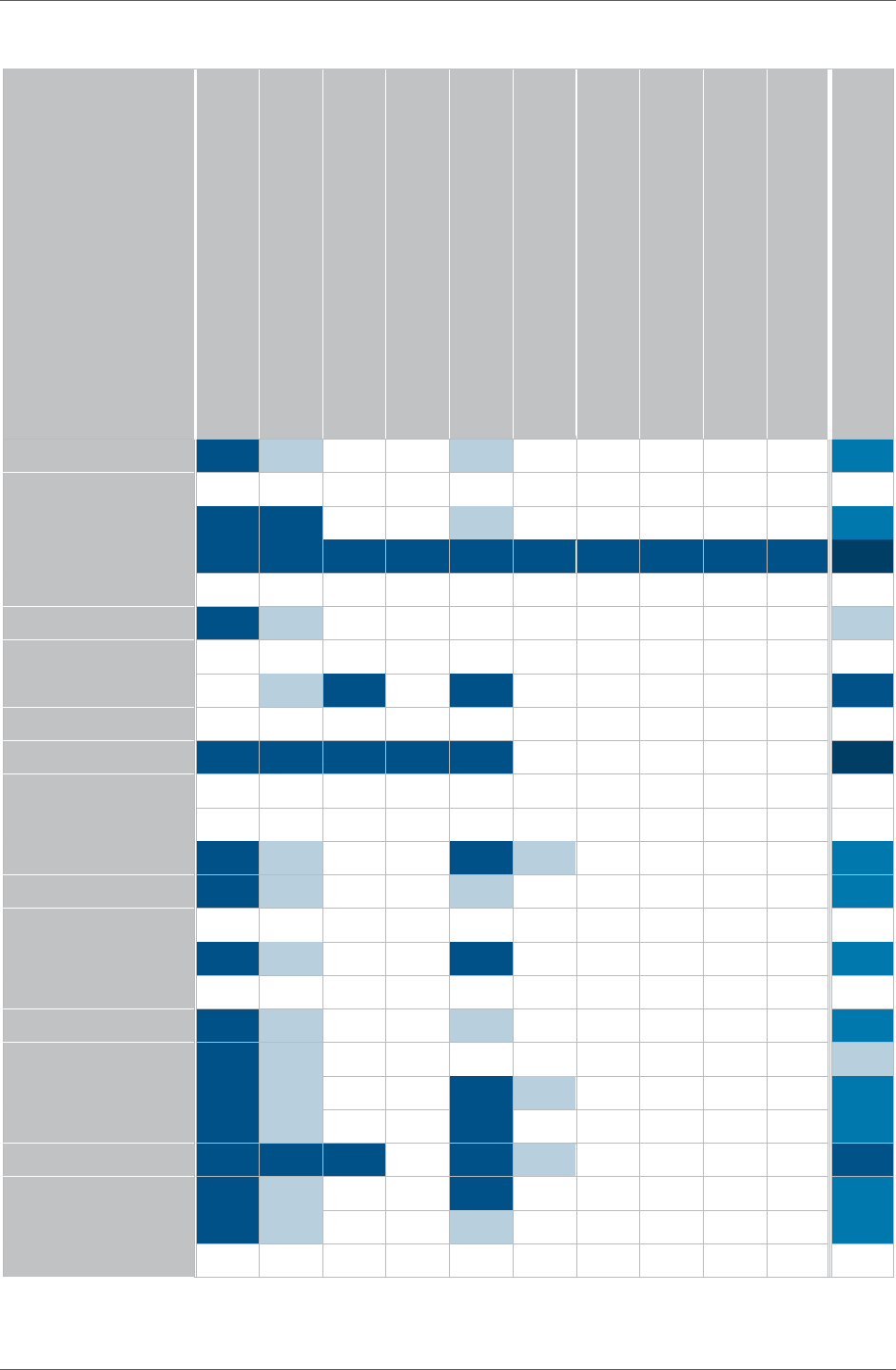
State Flood Risk Disclosure Best Practices
For Public Release 17
State
Whether the property is in a flood hazard
area and/or the FEMA Flood Zone
A federal requirement to purchase flood
insurance at the property
The presence of an active flood
insurance policy for the property
The current cost of flood insurance
premiums for the property
Previous flood events and/or flood
-
related
property damage
Any past flood insurance claims
Past flood insurance claim dates and
amount of damage
Any past disaster
-
related aid provided
Past disaster
-
related aid dates and
amounts
Other related disclosures (e.g., elevation
certificates)
Strength of Flood Risk Disclosure
Requirements
Iowa
1 0.5 0.5
2
Kansas
0
Kentucky
1 1 0.5
2.5
Louisiana
1 1 1 1 1 1 1 1 1 1
10
Maine
0
Maryland
1 0.5
1.5
Massachusetts
0
Michigan
0.5 1 1
2.5
Minnesota
0
Mississippi
1 1 1 1 1
5
Missouri
0
Montana
0
Nebraska
1 0.5 1 0.5
3
Nevada
1 0.5 0.5
2
New Hampshire
0
New Jersey
1 0.5 1
2.5
New Mexico
0
New York
1 0.5 0.5
2
North Carolina
1 0.5
1.5
North Dakota
1 0.5 1 0.5
3
Ohio
1 0.5 1
2.5
Oklahoma
1 1 1 1 0.5
4.5
Oregon
1 0.5 1
2.5
Pennsylvania
1 0.5 0.5
2
Puerto Rico
0
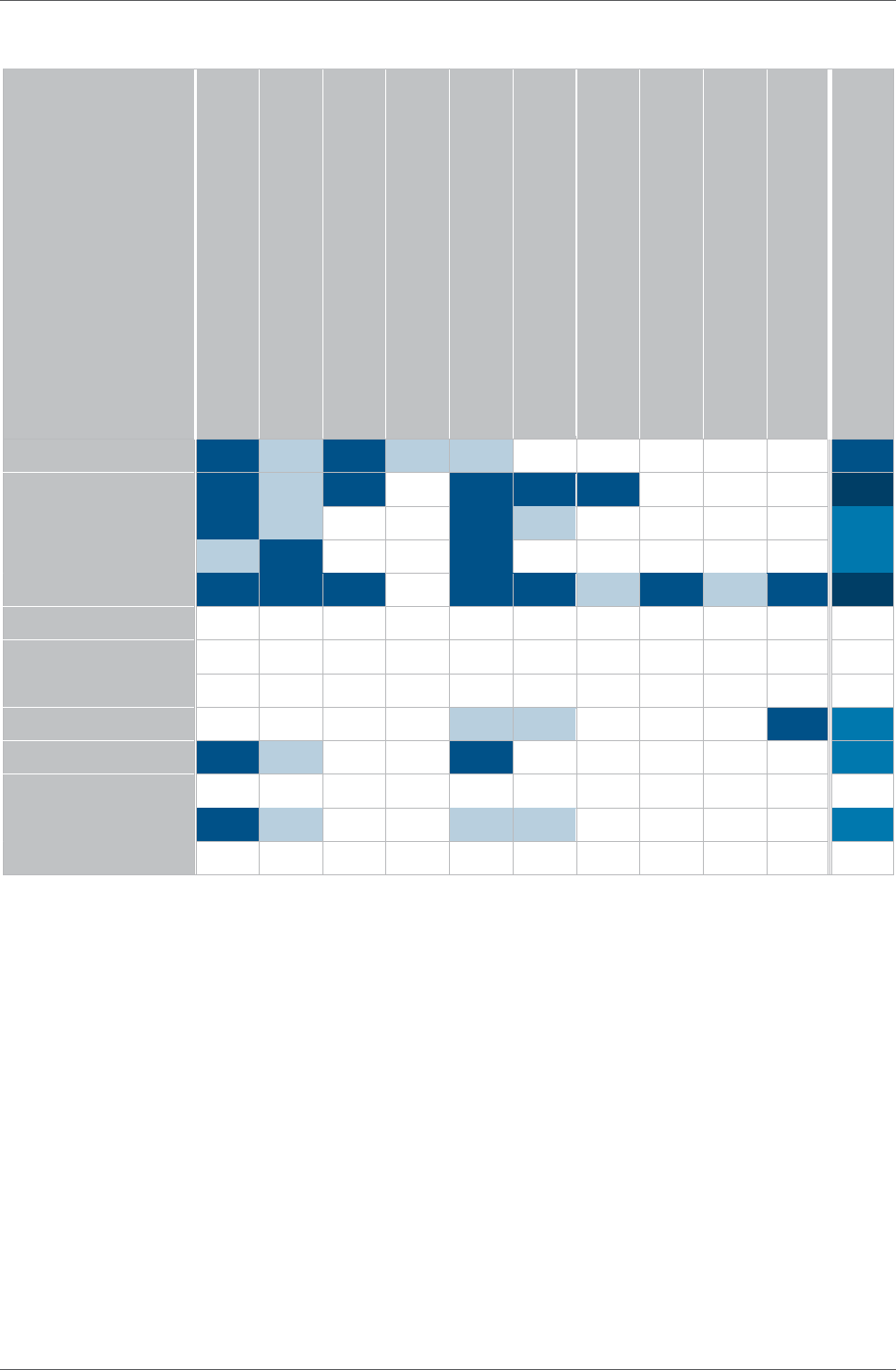
State Flood Risk Disclosure Best Practices
For Public Release 18
State
Whether the property is in a flood hazard
area and/or the FEMA Flood Zone
A federal requirement to purchase flood
insurance at the property
The presence of an active flood
insurance policy for the property
The current cost of flood insurance
premiums for the property
Previous flood events and/or flood
-
related
property damage
Any past flood insurance claims
Past flood insurance claim dates and
amount of damage
Any past disaster
-
related aid provided
Past disaster
-
related aid dates and
amounts
Other related disclosures (e.g., elevation
certificates)
Strength of Flood Risk Disclosure
Requirements
Rhode Island
1 0.5 1 0.5 0.5
3.5
South Carolina
1 0.5 1 1 1 1
5.5
South Dakota
1 0.5 1 0.5
3
Tennessee
0.5 1 1
2.5
Texas
1 1 1 1 1 0.5 1 0.5 1
8
Utah
0
Vermont
0
Virgin Islands
0
Virginia
0.5 0.5 1
2
Washington
1 0.5 1
2.5
West Virginia
0
Wisconsin
1 0.5 0.5 0.5
2.5
Wyoming
0
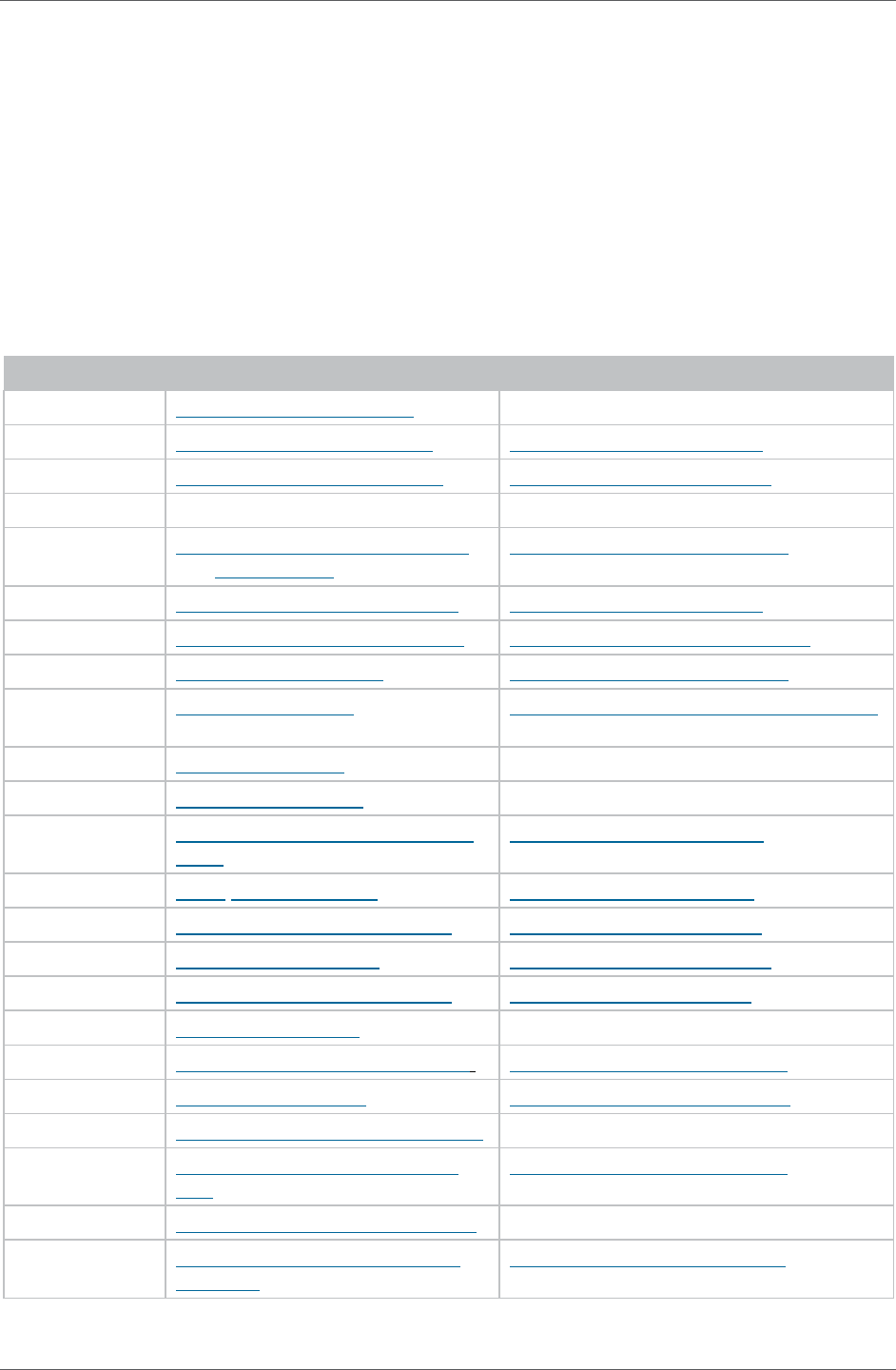
State Flood Risk Disclosure Best Practices
For Public Release 19
Appendix C: All State Statutes and Mandatory Disclosure
Forms
Table 2 provides links to the statutes and disclosure forms used in this analysis. This analysis
considered official state websites (e.g., “.gov” sites) to be authoritative. In some cases, state-
mandated disclosure forms were hosted on the state’s real estate commission site, which was also
considered authoritative. A few states’ references route through to third-party sites such as state
realtor’s associations or LexisNexis; these have been identified in italicized text.
Table 2: Links to Relevant Statutes and Forms
State Statute Number and Link Mandatory Disclosure Form Title and Link
Alabama Ala. Code § 34-27-36(a)(3) No form mandated by the state
Alaska Alaska Statutes § 34.70.010 Alaska Disclosure Statement
Arizona AZ Rev Stat 33-422, § 33-423 Arizona Disclosure Statement
Arkansas No state laws found No form mandated by the state
California California Code CIV 4.2.1.5-1102
and 4.2.1.7-1103
California Disclosure Statement
Colorado Colorado Title 38-35.7-101-110 Alaska Disclosure Statement
Connecticut Conn. Gen. Stat. Ann. § 20-327b Connecticut Disclosure Statement
Delaware Del. Code tit. 6, § 2572 Delaware Disclosure Statement
District of
Columbia
DC Code § 42-1302 District of Columbia Disclosure Statement
Florida FL Stat. § 475.278 No form mandated by the state
Georgia Georgia Title 44.1-16 No form mandated by the state
Hawaii Haw. Rev. Stat. §§ 508D-1, -4.5, -
7,-15
Hawaii Disclosure Statement
Idaho Idaho Code § 55-2508 Idaho Disclosure Statement
Illinois 225 Ill. Comp. Stat. 454/15-25 Illinois Disclosure Statement
Indiana Indiana Title 32.21.5-5 Indiana Disclosure Statement
Iowa Iowa Admin. Code r. 193E-14.1 Iowa Disclosure Statement
Kansas Stat. § 58-30,106(d) No form mandated by the state
Kentucky KY Rev Stat § 324.360(1), (2), (7) Kentucky Disclosure Statement
Louisiana LA Rev Stat § 9:3198 Louisiana Disclosure Statement
Maine Maine Rev. Stat. 32 § 13273(2)(A) No form mandated by the state
Maryland Md. Code Ann., Real Prop. § 10-
702
Maryland Disclosure Statement
Massachusetts 254 Mass. Code Regs 3.00(13)(c) No form mandated by the state
Michigan Mich. Comp. Laws §§ 565. 954,
957, 959
Michigan Disclosure Statement
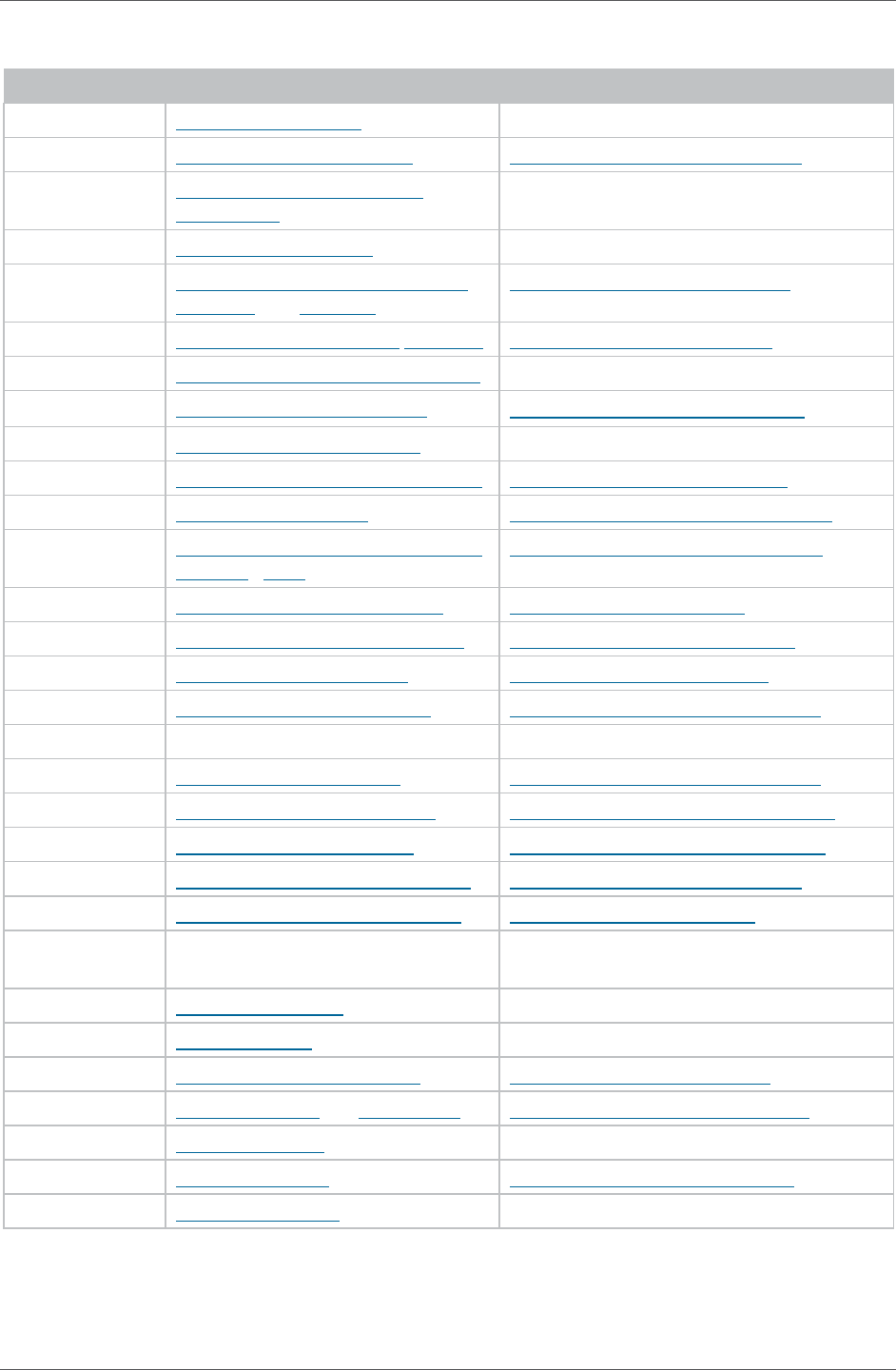
State Flood Risk Disclosure Best Practices
For Public Release 20
State Statute Number and Link Mandatory Disclosure Form Title and Link
Minnesota Minn. Stat. § 513.55 No form mandated by the state
Mississippi Mississippi Code 89-1-501 Mississippi Disclosure Statement
Missouri Missouri Revised Statutes §
339.730(3)
No form mandated by the state
Montana MT Code § 37-51-313 No form mandated by the state
Nebraska Nebraska Revised Statutes § 76-
2,120(2) and (6); 302
Nebraska Disclosure Statement
Nevada NV Rev Stat §§ 113.130, 113.140 Nevada Disclosure Statement
New Hampshire NH Revised Statutes § 331-A:25-b No form mandated by the state
New Jersey NJ Admin Code 13:45A-29.1
New Jersey Disclosure Statement
New Mexico N.M. Code R. § 16.61.19.8 No form mandated by the state
New York New York Laws RPP § 462(2), 465 New York Disclosure Statement
North Carolina 21 NCAC § 58A.0114 North Carolina Disclosure Statement
North Dakota North Dakota Century Code §§ 43-
23-08.3 - 12.1
North Dakota Disclosure Statement
Ohio Ohio Revised Code § 5302.30 Ohio Disclosure Statement
Oklahoma Okla. Stat. Title 60, §§ 833, 836 Oklahoma Disclosure Statement
Oregon OR Rev Stat § 105.464(2) Oregon Disclosure Statement
Pennsylvania Pa. Code §§ 35.284a, .335a Pennsylvania Disclosure Statement
Puerto Rico No Laws Found No form mandated by the territory
Rhode Island R.I. Gen. Laws § 5-20.8-2 Rhode Island Disclosure Statement
South Carolina S.C. Code Ann. § 27-50-40(A) South Carolina Disclosure Statement
South Dakota SD Codified Law § 43-4-44 South Dakota Disclosure Statement
Tennessee Tennessee Code § 66-5-201-210 Tennessee Disclosure Statement
Texas Texas Property Code Title 2 Ch 5 Texas Disclosure Statement
U.S. Virgin
Islands
No Laws Found No form mandated by the territory
Utah UT Code § 57-23-6 No form mandated by the state
Vermont 26 VSA § 2296 No form mandated by the state
Virginia Code of Virginia § 55.1-703 Virginia Disclosure Statement
Washington RCW 64.06.020 and 64.06.015 Washington Disclosure Statement
West Virginia WV Code § 1-5-3 No form mandated by the state
Wisconsin WI Stat § 709.03 Wisconsin Disclosure Statement
Wyoming WY Stat § 33-28-3 No form mandated by the state
